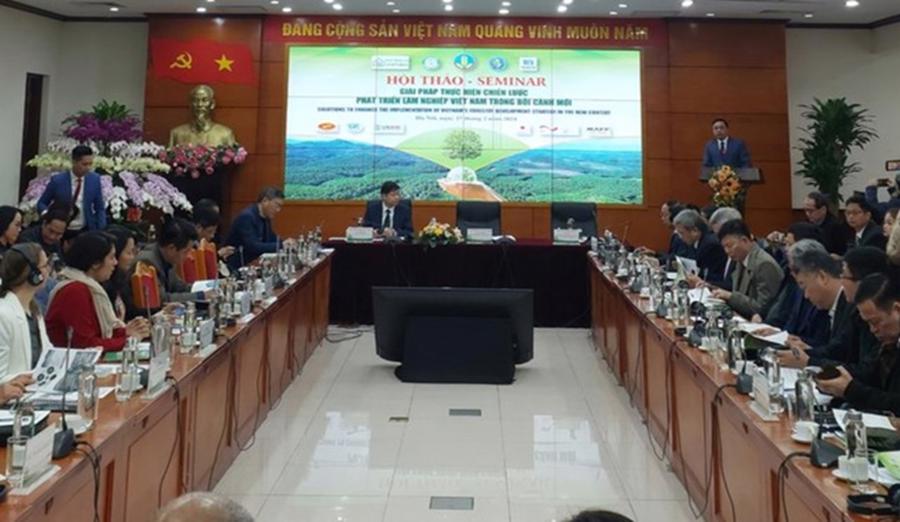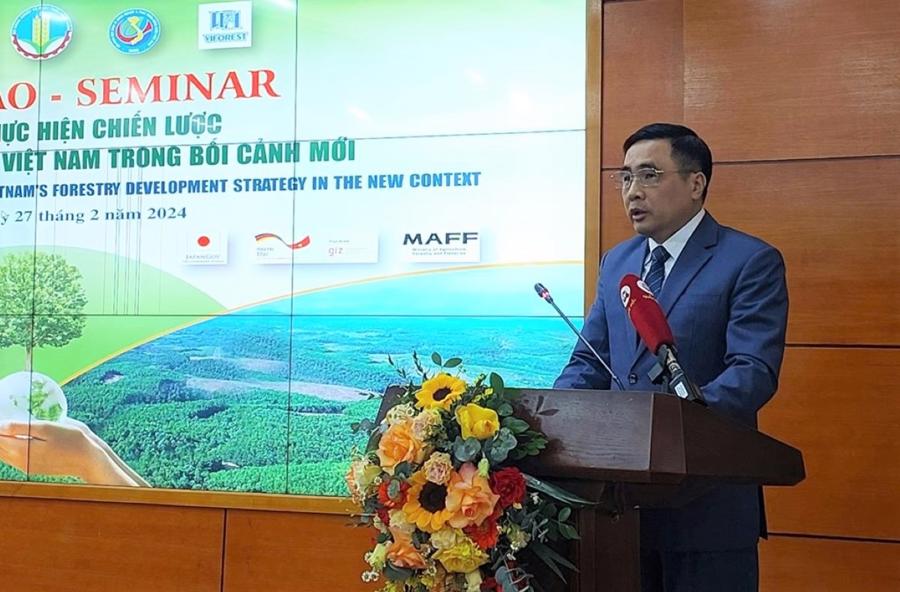On February 27, 2024, the Ministry of Agriculture and Rural Development in collaboration with the Vietnam Association of Agricultural Economics and Rural Development, the Vietnam Forestry Association, and the Vietnam Timber and Forest Product Association organized a seminar entitled “Looking Back on 3 Years of Implementing the Vietnam Forestry Strategy and the Impact of the 2024 Land Law Amendment on the Solutions for Implementing the Strategy in the Next Phase”.
4.6% ANNUAL GROWTH IN PRODUCTION VALUE
Mr. Trieu Van Luc, Deputy Director of the Department of Forestry (Ministry of Agriculture and Rural Development), stated that after 3 years of implementing the Vietnam Forestry Strategy, the legal system, mechanisms, and policies on forest management, protection, and development, as well as forestry development solutions, have been comprehensively and coherently implemented.
The structure of forestry production has shifted towards increasing value-added, with a stable growth rate of 4.6% per year. Each year, over 260 thousand hectares of forests are planted nationwide. The productivity and quality of planted forests have been improved, providing over 70% of the wood raw materials for timber processing, serving both exports and domestic consumption. The export value of wood and forest products reaches an average of USD 15.8 billion per year, with a high trade surplus ratio.

The revenue from forest environmental services averages VND 3,650 billion per year. In particular, in 2023, it reached VND 4,130 billion; of which, VND 997 billion came from forest carbon credit sales, contributing to reducing the pressure on the state budget.
According to a report from the Department of Forestry, the total mobilized funding for implementing the Strategy for Forest Protection and Development in the period 2021-2023 is around VND 56.7 trillion. Of which, the state budget accounts for nearly VND 12.6 trillion, revenue from forest environmental services accounts for nearly VND 11 trillion, and individual and organizational self-invested funding accounts for over VND 33 trillion.
“The forestry industry has made a significant contribution to the agricultural trade surplus with export values reaching USD 12.94 billion in 2021, USD 14.10 billion in 2022, and an estimated USD 12.199 billion in 2023.”
Mr. Trieu Van Luc, Deputy Director of the Department of Forestry.
In addition, according to information from the State Bank of Vietnam, the loan volume of credit institutions for the forestry sector from 2021 to October 2023 reached VND 886.7 trillion. Of which, loans for exploitation, plantation, care, and forest protection reached nearly VND 106.7 trillion; loans for processing and preservation reached VND 343.9 trillion; loans for purchasing and consuming forest products reached VND 416.2 trillion…
However, Mr. Luc mentioned that there are still existing difficulties and challenges in the implementation process of the Strategy. These include overlapping land use planning and the three types of forest planning, slow implementation of forest allocation and leasing, low productivity and quality of planted forests. The support level for forest protection and development, as well as the regime and policies for the forest protection force, are still relatively low and have not truly created motivation for forest protection and development. Many localities have not paid enough attention to investing and supplementing budgets for forest protection and development.
To mobilize resources more effectively for forest protection and development, the Department of Forestry proposes that the Ministry of Agriculture and Rural Development consider issuing a decree on investment policies in forestry. At the same time, it proposes that the Prime Minister approve the National Forestry Plan for the period 2021-2030, with a vision towards 2050; approve key projects in the forestry sector…
Furthermore, it suggests that the Government instruct the relevant ministries and local authorities to study and develop preferential credit and insurance policies to encourage and attract people and businesses to invest in large-scale afforestation linked to forest certification and deep processing to increase added value.
EMERGENCE OF NEW ISSUES
Assoc. Prof. Nguyen Ba Ngai, Vice Chairman and General Secretary of the Vietnam Forestry Association (VIFORA), stated that there are currently some issues in forest management and management of forest land. The 2024 Land Law, which takes effect from January 1, 2025, has certain provisions directly related to forest management and management of forest land.
“Currently, the category of land used for forest protection and development has many unclear points and difficult-to-determine criteria, making it difficult for forest management statistics and monitoring because this category of land includes the area of forests being promoted for reforestation but not yet classified as forests; land with planted forests but not yet classified as forests; land for constructing facilities for forest protection and development such as firebreaks…”, Mr. Ngai said.
According to the Land Law, forest land includes three groups: production forests, protection forests, and special-use forests. The Forestry Law does not define land without forests. Meanwhile, according to the Forestry Law, forestry land includes land area with forests and land area without forests.
“The data on forestry land area published by the Department of Natural Resources and Environment is not consistent with the data on forest area published by the Department of Agriculture; there are even inconsistencies,” Mr. Ngai emphasized, also stating that the forest area assigned to the local community is higher than the forestry land area assigned to the local community; the forest area managed by the commune is more than 1 million hectares higher than the forestry land area managed by the commune. These are long-standing issues that greatly affect forest management and management of forestry land.
In view of this reality, Mr. Nguyen Van Tien, Deputy Chairman of the Vietnam Association of Agricultural Economics and Rural Development, recommended that the Ministry of Agriculture and Rural Development promptly improve the forestry plan to ensure consistency with land use planning at the national, provincial, and district levels. Properly allocate land funds that are suitable for land use requirements and closely manage the conversion of land use purposes in forestry.
Moreover, it is necessary to enhance the access to land for entities with production and business demands in forestry. To supplement the recipients of forestry land use rights transfer.
From the perspective of state management agencies, Mr. Nguyen Quoc Tri, Deputy Minister of Agriculture and Rural Development, assessed that the achievements obtained after 3 years of implementing the Vietnam Forestry Development Strategy for the period 2021-2030 are increasingly important contributions to socio-economic development, ecological environmental protection, disaster mitigation, proactive response to climate change, ensuring national defense and security, and successfully achieving national sustainable development goals.
However, some important indicators have not been achieved according to the set plan, such as wood and forest product export turnover or the added value of the forestry sector not corresponding to its potential. The forestry industry has faced unpredictable fluctuations, such as wars or climate change.

“The forestry sector is facing opportunities and challenges intertwined in the context of new situations both domestically and internationally. Among them are changes in regulations from related laws and legal documents, such as the 2024 Land Law; Conclusion No. 61 of the Secretariat on continuing to implement Directive No. 13; new regulations on Vietnam’s commitments to international commitments, such as the commitment to achieve net-zero emissions by 2050, implementing the EU Forest Law Enforcement, Governance and Trade (FLEGT), and implementing the regulations on forest carbon credits…”
Therefore, the forestry sector needs to propose solutions to mobilize, manage, and effectively use resources to fulfill the approved targets and strategies.”




































